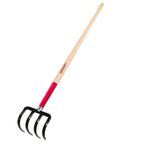Build Your Own Potato Growing Box
This technique can produce a bumper crop of potatoes in a small area

You may be wondering, “Don’t you mean potato grow box?” Nope, that’s not a typo. As the areas of my garden devoted to perennials has gradually increased, the need to use the remaining space more efficiently has become more important. Using trellises and other vertical growing methods greatly help in this challenge.
Though my first attempts at growing potatoes the last couple of years have been successful, the potatoes took up a fair portion of the raised beds they were growing in. This year, I am again doing another “first”—growing potatoes vertically. The “potato box” or “spud box” has become an effective method to produce a large quantity of potatoes in a small space. The idea is ingenious; forcing the potato plant to “stretch” upward as it grows allows more area of the plant to produce potatoes.
The potato “growing” box is just that—a series of frames that stack, or grow, as the potato plant grows. I like to look at the frames as resembling the floors of a building. In this project, our potato “building” will be six stories tall.
What you need
1. Six—2-inch by 6-inch by 8-foot untreated wood boards
2. Two—2-inch by 2-inch by 6-foot wood studs (or one 12-foot-long stud) Note: I actually went with 2x3s instead of 2x2s because they were straighter. For the purpose of this project, we’ll stick with 2x2s to avoid confusion.
3. About 65—2½-inch long deck screws (I just got a 1-pound box of them; it’s less expensive. You’ll have extras, but you’ll probably need them later.)
4. Drill and drill bits
Skill level
Easy to intermediate
Construction
1. Cut the two 2-inch by 2-inch by 6-foot studs into four 33-inch pieces. (You’ll have a few inches left over.)
2. Cut the six 2-inch by 2-inch by 8-foot boards into 12 lengths of 21 inches and 12 lengths of 24 inches.
3. Drill two holes on each end of the 24-inch pieces, about ¾ inch from the edge. This will position the screws to go into the center of the cut side of the 21-inch pieces.
4. Screw two of the 24-inch pieces and two of the 21-inch pieces together to form a “frame.”
5. Repeat step 4 five more times. This will give you a total of six frames. These six frames will stack on top of each other, creating your box.
6. Place one of the 2-inch by 2-inch by 33-inch stud pieces to the inside corner of one of the frames. This frame will be the base (or the bottom floor) of the box.
7. Drill two holes on the outside of this frame so they align with the stud you placed in the corner of the frame. Here, the screws will anchor the stud into the corner of the frame in two spots.
8. Repeat step 7 for the remaining three inside corners of the frame. The base of the box will now look like an upside-down square table.
9. Slip one of the other frames onto the base frame, with the four “legs” being on the inside. These two “floors” will be the area we will plant in. Note: If you wish to dig into the ground to plant your seed potatoes, you can omit this step for now. I simply chose to start the potatoes inside the box, rather than digging into the ground below the box.
Planting and growing
10. Find the location (full sun preferably) for your box, and clear away any sod, rocks, or debris. Place the box into position.
11. Prepare the soil at the base of the box. You can use your existing soil if it has good drainage and has some organic matter already in it. Otherwise, potting soil, compost, or finely chopped mulch can be added. I used a mix that was about 40% compost; 40% chopped leaves, straw, and grass clippings; and 20% existing soil. I filled the bottom two frames with the mix, almost to the top edge.
12. Plant the seed potatoes about 3 to 4 inches deep, and cover with soil. I added a thin layer of larger leaves as a mulch.
13. When your potato plants are about a foot high, add another frame and fill it with more soil, covering no more than a third of the plant. Continue this process through the season, until the remaining frames have been added.
Harvesting
14. To harvest, remove the bottom frame’s boards to access the bottom layer of soil. When all of the potatoes have been removed from this level, replace the soil and reattach the boards. To harvest more potatoes, repeat those same steps with the second frame’s boards—and so on, and so on, until you’ve reached the top frame.
Enjoy the fresh spud greatness!
Photos: Greg Holdsworth
Fine Gardening Recommended Products

The New Organic Grower, 3rd Edition: A Master's Manual of Tools and Techniques for the Home and Market Gardener, 30th Anniversary Edition
Fine Gardening receives a commission for items purchased through links on this site, including Amazon Associates and other affiliate advertising programs.

Razor-Back Potato/Refuse Hook
Fine Gardening receives a commission for items purchased through links on this site, including Amazon Associates and other affiliate advertising programs.

Chapin International 10509 Upside-Down Trigger Sprayer
Fine Gardening receives a commission for items purchased through links on this site, including Amazon Associates and other affiliate advertising programs.



















Comments
Log in or create an account to post a comment.
Sign up Log in